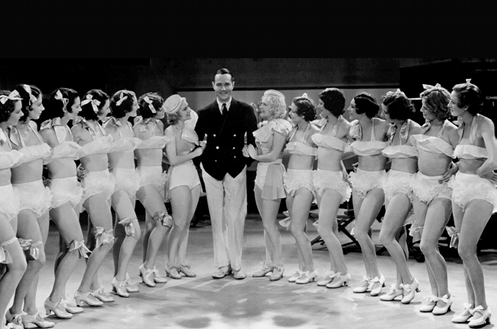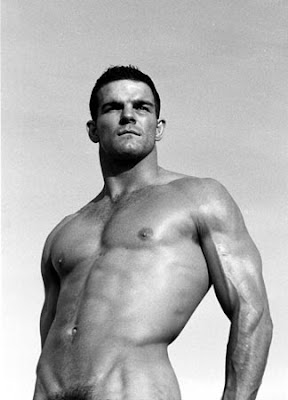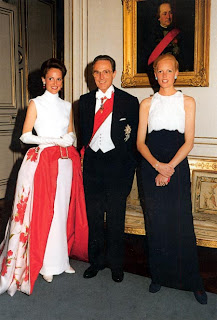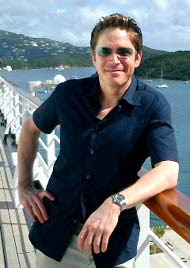I’ve written about gay king Frederick the Great of Prussia. However, I just learned that a former aide of his had to flee Prussia amid allegations of taking familiarities with young boys.
Baron Friedrich Wilhelm von Steuben, an experienced military officer, made his way to America with the aid of
Benjamin Franklin, who was based in Paris at the time, trying to convince the French to come to our aid in fighting the British.
George Washington asked for the Baron’s assistance in bringing order to the tattered Continental troops serving in the Revolutionary War. General Washington sent him to Valley Forge in February, 1778.
The soldiers were unaccustomed to the Baron’s – well, let’s call it "style". Von Steuben showed up in a grandiose sleigh (sporting 24 jingling bells) pulled by black Percheron draft horses. The Baron was wearing a robe of silk trimmed with fur, all the while petting his miniature greyhound, Azor, who was curled up on his lap. Behind him were his retinue of African servants, a French chef, his French aide-de-camp
Louis de Pontière and the Baron’s 17-year-old lover/secretary
Pierre-Étienne du Ponceau.
Impressive, if not entirely appropriate.
However, von Steuben proved his worth and soon shaped a hundred soldiers into a model company that, in turn, trained others in Prussian military tactics. He was a mere captain, but was so invaluable to Washington, that he was promoted to Major General. In 1781, he served under the Marquis de Lafayette in Virginia when the British General Charles Cornwallis invaded. He also served at the siege of Yorktown, where he commanded one of the three divisions of Washington's army.
Steuben spoke little English, and he often yelled to his translator, "Hey! Come over here and swear for me!" Steuben punctuated the screaming of his translator with fierce-sounding shouts in German and French. In an effort to codify training, Steuben wrote a
Revolutionary War Drill Manual, which became the standard method for training army troops for over thirty years. It addresses the arms and accoutrements of officers and soldiers, formation and exercise of a company, instruction of recruits, formation and marching, inspection, etc., etc.
Steuben became an American citizen by act of the Pennsylvania legislature in March 1784. In 1790, Congress gave him a pension of $2,500 a year, which he received until his death, and an estate near Utica, NY, granted to him for his military service to our nation.
But wait, that’s not all. Steuben legally adopted two handsome soldiers (one of them,
William North, became a U.S. Senator). A third young man,
John Mulligan, considered himself a member of the stable of Steuben’s “sons.” Before moving in with Steuben, Mulligan had been living with
Charles Adams*, the son of then-Vice President John Adams. Adams was concerned about the intense “closeness” between his son and Mulligan, insisting that they split up, so Mulligan wrote to Von Steuben with his tale of despair. Actually, Von Steuben offered to take both men into his
arms home. Charles Adams, the handsomest son of one president and brother of another (John Quincy), resided with Von Steuben and Mulligan for a while. The 19-year-old Mulligan received – how shall we say – a very warm welcome. Von Steuben was a 62-year-old bachelor at the time. Hmmm.
Adams left the cozy love nest after a short while, but Mulligan stayed on for several years, serving as Von Steuben’s “secretary” until the Baron’s death. Mulligan inherited von Steuben’s library, maps and $2,500 cash, a considerable amount at the time, especially considering that the Baron was not a wealthy man.
Every year since 1958 the
German-American Steuben Parade has been held in New York City. It is one of the city’s largest parades and is traditionally followed by an Oktoberfest celebration in Central Park. Similar events take place in Chicago and Philadelphia. Chicago’s Steuben Day Parade was featured in the movie
Ferris Bueller's Day Off. To further honor von Steuben, the
Steuben Society was founded in 1919 as an educational, fraternal, and patriotic organization of American citizens of German background. In the difficult post-WW I years the Society helped the German-American community reorganize.
Steubenville, Ohio, is named in the Baron’s honor. As well, numerous submarines, warships and ocean liners were named after him. A statue of the Baron stands in Lafayette Square opposite the White House in Washington, DC*. Even one of the cadet barracks buildings at
Valley Forge Military Academy and College is named after Von Steuben. Really.
Steuben was cited by Randy Shilts in his book,
Conduct Unbecoming, as an early example of a valuable homosexual in the military.
*I traipsed over to Lafayette Park yesterday afternoon to inspect the statue of Baron von Steuben. It’s a tall bronze life-size statue placed upon a high stone pedestal. The statue shows von Steuben in military dress uniform surveying the troops at Valley Forge. The monument, which stands opposite the White House, was erected in 1911 and sculpted by
Albert Jaegers. At the rear of the pedestal is a medallion with the images of von Steuben's adopted aides-de-camp, William North and Benjamin Walker, facing one another. It says: "Colonel William North - Major Benjamin Walker - Aides and Friends of von Steuben". On each side of the pedestal are bronze Roman soldiers. Above the carved words “military instruction” on one side is a seated, helmeted Roman soldier “instructing” a naked youth (photo at left). Appropriate, no?
Check it out the next time you come to Washington DC.
*In 1796
Charles Adams was one of a group of men who frequented the theater in New York City and wrote critiques of what they saw for further distribution. Others in the group, called the
Friendly Club, were John Wells, Elias Hicks, Samuel Jones, William Cutting and Peter Irving. This is noted in William Dunlap's "
History of the American Theatre," published in 1832 (p. 193). Adams, whose father vowed never to see him again after Charles abandoned his wife and two daughters, drank himself to death in 1800, succumbing to alcoholism at the tender age of 30. Some scholars believe this was caused by his inability to deal with his homosexual leanings. Charles Adams, who streaked naked across the campus of Harvard during his student days, had a reputation as a rogue and renegade, and his family's wall of silence after his death may support that theory. Charles certainly spent much time in the company of men who engaged in homosexual activity. In researching this post, I enjoyed a cheap smile over the fact that the law office of young Adams was located on Little Queen Street (since renamed Cedar St. in the financial district).

























































